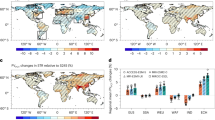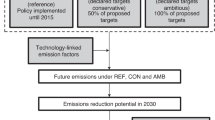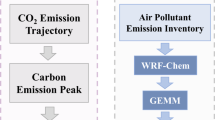Abstract
China pledged to achieve carbon neutrality by 2060 to combat global climate change, yet the resulting multi-aspect domestic impacts are not fully analysed due to an incomplete understanding of the underlying anthropogenic–natural interactions. Building an integrated cross-disciplinary modelling framework that can capture the feedbacks of changing aerosols on meteorology, here we highlight the amplified air quality, human health and renewable energy self-reinforcing synergies of China’s carbon neutral target in comparison to the baseline in 2015 and 2060. We find that owing to emissions reduction and more favourable meteorological conditions caused by less aerosol, achieving China’s carbon neutrality target in 2060 reduces national population-weighted PM2.5 concentrations and associated premature deaths by ~39 μg m−3 and 1.13 (95% confidence interval: 0.97–1.29) million while boosting provincial solar (wind) power performance by up to ~10% (~6%) with mostly decreased resource variability in comparison to the 2060 baseline. Enhanced renewable performance along with low-carbon energy transition may provide additional opportunities to address the remaining air pollution and associated human health damages upon achieving carbon neutrality. Our results highlight that global developing and polluting countries’ pledge for carbon neutrality can produce important positive feedbacks between aerosols mitigation, air quality improvement and enhanced renewable energy, which can be amplified via weakened aerosol–meteorology interactions and better atmospheric dispersion.
This is a preview of subscription content, access via your institution
Access options
Access Nature and 54 other Nature Portfolio journals
Get Nature+, our best-value online-access subscription
$29.99 / 30 days
cancel any time
Subscribe to this journal
Receive 12 print issues and online access
$259.00 per year
only $21.58 per issue
Buy this article
- Purchase on Springer Link
- Instant access to full article PDF
Prices may be subject to local taxes which are calculated during checkout





Similar content being viewed by others
Data availability
Meteorology data for 2015 are obtained from the 1-hour ERA5 climate reanalysis dataset (https://cds.climate.copernicus.eu/#!/search?text=ERA5&type=dataset)53; natural and anthropogenic fire emissions are from the Fire INventory from NCAR (FINN; https://www2.acom.ucar.edu/modeling/finn-fire-inventory-ncar)54; anthropogenic emissions are from the DPEC emissions inventory v1.1 (http://meicmodel.org.cn/?page_id=1918&lang=en)55; 2060 meteorological data are available via figshare at https://doi.org/10.6084/m9.figshare.16802326 (ref. 56). Source codes of the WRF-Chem model utilized in this study are available at https://github.com/wrf-model/WRF/releases/tag/V3.6.1. All source data generated or analysed during this study are included in this published paper (and its Supplementary Information) and are available at https://doi.org/10.6084/m9.figshare.25302031 (ref. 57).
Code availability
The Python and R scripts for processing and plotting results in this study are available at https://doi.org/10.6084/m9.figshare.25302031 (ref. 57).
References
China Statistical Yearbooks (NBSC, 2021).
Working Guidance for Carbon Dioxide Peaking and Carbon Neutrality in Full and Faithful Implementation of the New Development Philosophy (CPC Central Committee and the State Council, 2021); http://www.gov.cn/xinwen/2021-10/24/content_5644613.htm
Zhu, W. K., Wang, C. Y., Wang, L. S., Wu, X. H. & Yue, Q. Analysis of energy-saving and environmental benefits from power structure adjustment in China: a comparative study from 2020 to 2060. Sustain. Prod. Consump. 31, 750–761 (2022).
Data Explorer (EMBER, 2024); https://ember-climate.org/data/data-explorer/
Cheng, J. et al. Pathways of China’s PM2.5 air quality 2015–2060 in the context of carbon neutrality. Natl Sci. Rev. 8, nwab078 (2021).
International Energy Agency An Energy Sector Roadmap to Carbon Neutrality in China (IEA, 2021); https://www.iea.org/reports/an-energy-sector-roadmap-to-carbon-neutrality-in-china
Siler-Evans, K., Azevedo, I. L., Morgana, M. G. & Apt, J. Regional variations in the health, environmental, and climate benefits of wind and solar generation. Proc. Natl Acad. Sci. USA 110, 11768–11773 (2013).
Yang, J. N., Li, X. Y., Peng, W., Wagner, F. & Mauzerall, D. L. Climate, air quality and human health benefits of various solar photovoltaic deployment scenarios in China in 2030. Environ. Res. Lett. 13, 064002 (2018).
Boudri, J. C. et al. The potential contribution of renewable energy in air pollution abatement in China and India. Energy Policy 30, 409–424 (2002).
Qin, Y. et al. Air quality, health, and climate implications of China’s synthetic natural gas development. Proc. Natl Acad. Sci. USA 114, 4887–4892 (2017).
Qin, Y. et al. Air quality–carbon–water synergies and trade-offs in China’s natural gas industry. Nat. Sustain. 1, 505–511 (2018).
Yang, J. Z., Zhao, Y., Cao, J. & Nielsen, C. P. Co-benefits of carbon and pollution control policies on air quality and health till 2030 in China. Environ. Int. 152, 106482 (2021).
Zhang, S. & Chen, W. Y. Assessing the energy transition in China towards carbon neutrality with a probabilistic framework. Nat. Commun. 13, 87 (2022).
Liu, J. Y. et al. Identifying trade-offs and co-benefits of climate policies in China to align policies with SDGs and achieve the 2 degrees C goal. Environ. Res. Lett. 14, 124070 (2019).
Yang, X. & Teng, F. Air quality benefit of China’s mitigation target to peak its emission by 2030. Clim. Policy 18, 99–110 (2018).
Zhang, S. H. et al. Incorporating health co-benefits into technology pathways to achieve China’s 2060 carbon neutrality goal: a modelling study. Lancet Planet. Health 5, E808–E817 (2021).
Shi, X. R. et al. Air quality benefits of achieving carbon neutrality in China. Sci. Total Environ. 795, 148784 (2021).
Xu, B. Y. et al. Impacts of regional emission reduction and global climate change on air quality and temperature to attain carbon neutrality in China. Atmos. Res. 279, 106384 (2022).
IPCC Climate Change 2021: The Physical Science Basis (eds Masson-Delmotte, V. et al.) (Cambridge Univ. Press, 2021); https://doi.org/10.1017/9781009157896
Hong, C. P. et al. Weakening aerosol direct radiative effects mitigate climate penalty on Chinese air quality. Nat. Clim. Change 10, 845–850 (2020).
Zhou, M. et al. The impact of aerosol-radiation interactions on the effectiveness of emission control measures. Environ. Res. Lett. 14, 024002 (2019).
Ding, A. J. et al. Enhanced haze pollution by black carbon in megacities in China. Geophys. Res. Lett. 43, 2873–2879 (2016).
Huang, X., Wang, Z. L. & Ding, A. J. Impact of aerosol–PBL interaction on haze pollution: multiyear observational evidences in North China. Geophys. Res. Lett. 45, 8596–8603 (2018).
Cheng, J. et al. A synergistic approach to air pollution control and carbon neutrality in China can avoid millions of premature deaths annually by 2060. One Earth 6, 978–989 (2023).
Liu, Y. et al. Role of climate goals and clean-air policies on reducing future air pollution deaths in China: a modelling study. Lancet Planet. Health 6, E92–E99 (2022).
Xia, X. G., Chen, H. B., Li, Z. Q., Wang, P. C. & Wang, J. K. Significant reduction of surface solar irradiance induced by aerosols in a suburban region in northeastern China. J. Geophys. Res.: Atmos. 112, D22S02 (2007).
Yang, X., Zhao, C. F., Zhou, L. J., Wang, Y. & Liu, X. H. Distinct impact of different types of aerosols on surface solar radiation in China. J. Geophys. Res.: Atmos. 121, 6459–6471 (2016).
Li, Z. Q. et al. Aerosol optical properties and their radiative effects in northern China. J. Geophys. Res.: Atmos. 112, D22S01 (2007).
Sweerts, B. et al. Estimation of losses in solar energy production from air pollution in China since 1960 using surface radiation data. Nat. Energy 4, 657–663 (2019).
Shi Chen et al. Improved air quality in China can enhance solar-power performance and accelerate carbon-neutrality targets. One Earth 5, 550–562 (2022).
Zhou, M. et al. Environmental benefits and household costs of clean heating options in northern China. Nat. Sustain. 5, 329–338 (2022).
Qin, Y. et al. Environmental consequences of potential strategies for China to prepare for natural gas import disruptions. Environ. Sci. Technol. 56, 1183–1193 (2022).
Huang, X. et al. Direct radiative effect by multicomponent aerosol over China. J. Clim. 28, 3472–3495 (2015).
Xing, J. et al. The quest for improved air quality may push China to continue its CO2 reduction beyond the Paris Commitment. Proc. Natl Acad. Sci. USA 117, 29535–29542 (2020).
WHO Air Quality Database (WHO, 2022); https://www.who.int/data/gho/data/themes/air-pollution/who-air-quality-database
Kniesner, T. J. & Viscusi, W. K. The value of a statistical life. Economics and Finance https://doi.org/10.1093/acrefore/9780190625979.013.138 (2019).
Xu, Xl. China’s multi-year provincial administrative division boundary data. The Resource and Environment Science and Data Center, Institute of Geographic Sciences and Natural Resources Research, Chinese Academy of Sciences https://doi.org/10.12078/2023010103 (2023).
Tong, D. et al. Dynamic projection of anthropogenic emissions in China: methodology and 2015–2050 emission pathways under a range of socio-economic, climate policy, and pollution control scenarios. Atmos. Chemis. Phys. 20, 5729–5757 (2020).
Ramanathan, V., Crutzen, P. J., Kiehl, J. T. & Rosenfeld, D. Atmosphere–aerosols, climate, and the hydrological cycle. Science 294, 2119–2124 (2001).
Hansen, J., Sato, M. & Ruedy, R. Radiative forcing and climate response. J. Geophys. Res.: Atmos. 102, 6831–6864 (1997).
Huang, X. et al. Amplified transboundary transport of haze by aerosol-boundary layer interaction in China. Nat. Geosci. 13, 428–434 (2020).
Chapman, E. G. et al. Coupling aerosol-cloud-radiative processes in the WRF-Chem model: investigating the radiative impact of elevated point sources. Atmos. Chem. Phys. 9, 945–964 (2009).
Xu, Z. F., Han, Y., Tam, C. Y., Yang, Z. L. & Fu, C. B. Bias-corrected CMIP6 global dataset for dynamical downscaling of the historical and future climate (1979–2100). Sci. Data 8, 293 (2021).
Ginoux, P. et al. Sources and distributions of dust aerosols simulated with the GOCART model. J. Geophys. Res.: Atmos. 106, 20255–20273 (2001).
Zhou, X. X. et al. An overview of power transmission systems in China. Energy 35, 4302–4312 (2010).
Wang, T. T. & Sun, F. B. Global gridded GDP data set consistent with the shared socioeconomic pathways. Sci. Data 9, 221 (2022).
Burnett, R. et al. Global estimates of mortality associated with long-term exposure to outdoor fine particulate matter. Proc. Natl Acad. Sci. USA 115, 9592–9597 (2018).
Yang, H., Huang, X. Y., Westervelt, D. M., Horowitz, L. & Peng, W. Socio-demographic factors shaping the future global health burden from air pollution. Nat. Sustain. 6, 58–68 (2023).
Jerez, S. et al. The impact of climate change on photovoltaic power generation in Europe. Nat. Commun. 6, 10014 (2015).
Feron, S., Cordero, R. R., Damiani, A. & Jackson, R. B. Climate change extremes and photovoltaic power output. Nat. Sustain. 4, 270–276 (2021).
Pryor, S. C., Barthelmie, R. J., Bukovsky, M. S., Leung, L. R. & Sakaguchi, K. Climate change impacts on wind power generation. Nat. Rev. Earth Environ. 1, 627–643 (2020).
Tong, D. et al. Geophysical constraints on the reliability of solar and wind power worldwide. Nat. Commun. 12, 6146 (2021).
ERA5 climate reanalysis dataset. Copernicus https://cds.climate.copernicus.eu/#!/search?text=ERA5&type=dataset (2024).
FINN. NCAR https://www2.acom.ucar.edu/modeling/finn-fire-inventory-ncar (2024).
DPEC emission inventory. MEICModel http://meicmodel.org.cn/?page_id=1918&lang=en (2024).
Metadata record for: bias-corrected CMIP6 global dataset for dynamical downscaling of the historical and future climate (1979–2100). figshare https://doi.org/10.6084/m9.figshare.16802326 (2021).
Qin, Y. Amplified positive environmental and energy effects under China' carbon neutrality. figshare https://doi.org/10.6084/m9.figshare.25302031 (2024).
Acknowledgements
The work was financially supported by the National Natural Science Foundation of China grant number 42325506 to X. Huang, grant number 42277482 to Y.Q. and Fundamental Research Funds for the Central Universities (14380198) to A.D. M.Z. acknowledges support from the Princeton School of Public and International Affairs and its Center for Policy Research on Energy and the Environment. C.Z. acknowledges National Key R&D Program of China (grant number 2023YFF0613900). X. He acknowledges the Top-Notch Young Talents Program of China.
Author information
Authors and Affiliations
Contributions
Y.Q. and X. Huang designed this study. X. Huang, M.Z., Y.Q., Y.H., D.T., L.H., C.Z., J.C., W.G., L.W., X. He, D.Z. and Q.C. led the model simulations and analysed the data. Y.Q., X. Huang, M.Z., A.D. and T.Z. wrote the paper with input from all co-authors.
Corresponding authors
Ethics declarations
Competing interests
The authors declare no competing interests.
Peer review
Peer review information
Nature Geoscience thanks Jinyue Yan and the other, anonymous, reviewer(s) for their contribution to the peer review of this work. Primary Handling Editor: Xujia Jiang, in collaboration with the Nature Geoscience team.
Additional information
Publisher’s note Springer Nature remains neutral with regard to jurisdictional claims in published maps and institutional affiliations.
Extended data
Extended Data Fig. 1 Provincial PM2.5 surface concentration changes due to aerosols’ radiative effects across mainland China in 2015.
(a, b) Area-weighted (A-W) and (c, d) population-weighted (P-W) PM2.5 surface concentration changes in (a, c) absolute and (b, d) percentage changes across mainland China due to aerosols’ radiation interactions (ARI) in 2015. Base map data are from the Resource and Environment Science and Data Center, Institute of Geographic Sciences and Natural Resources Research, Chinese Academy of Sciences (https://doi.org/10.12078/2023010103, 2023)1.
Extended Data Fig. 2 Provincial solar radiation and wind speed changes due to aerosols’ radiative effects across mainland China in 2015.
(a, b) Solar radiation and (c, d) wind speed changes in (a, c) absolute and (b, d) percentage changes across mainland China. Base map data are from the Resource and Environment Science and Data Center, Institute of Geographic Sciences and Natural Resources Research, Chinese Academy of Sciences (https://doi.org/10.12078/2023010103, 2023)1.
Extended Data Fig. 3 2060 Provincial PM2.5 surface concentrations in mainland China.
Area-weighted (A-W) and population-weighted (P-W) PM2.5 surface concentration in (a-d) 2060 Baseline scenario and (e-h) 2060 Carbon neutral scenario, with (ARIon) and without (ARIoff) considering aerosols’ radiation interactions respectively. Base map data are from the Resource and Environment Science and Data Center, Institute of Geographic Sciences and Natural Resources Research, Chinese Academy of Sciences (https://doi.org/10.12078/2023010103, 2023)1.
Extended Data Fig. 4 2060 Provincial PM2.5 associated premature deaths in mainland China.
PM2.5 associated premature deaths in (a,b) 2060 Baseline scenario, (c,d) 2060 Carbon neutral scenario with (ARI_on) and without (ARI_off) considering aerosols’ radiation interactions respectively. Base map data are from the Resource and Environment Science and Data Center, Institute of Geographic Sciences and Natural Resources Research, Chinese Academy of Sciences (https://doi.org/10.12078/2023010103, 2023)1.
Supplementary information
Supplementary Information
Supplementary Notes, Figs. 1–15 and Tables 1–7.
Rights and permissions
Springer Nature or its licensor (e.g. a society or other partner) holds exclusive rights to this article under a publishing agreement with the author(s) or other rightsholder(s); author self-archiving of the accepted manuscript version of this article is solely governed by the terms of such publishing agreement and applicable law.
About this article
Cite this article
Qin, Y., Zhou, M., Hao, Y. et al. Amplified positive effects on air quality, health, and renewable energy under China’s carbon neutral target. Nat. Geosci. 17, 411–418 (2024). https://doi.org/10.1038/s41561-024-01425-1
Received:
Accepted:
Published:
Issue Date:
DOI: https://doi.org/10.1038/s41561-024-01425-1



